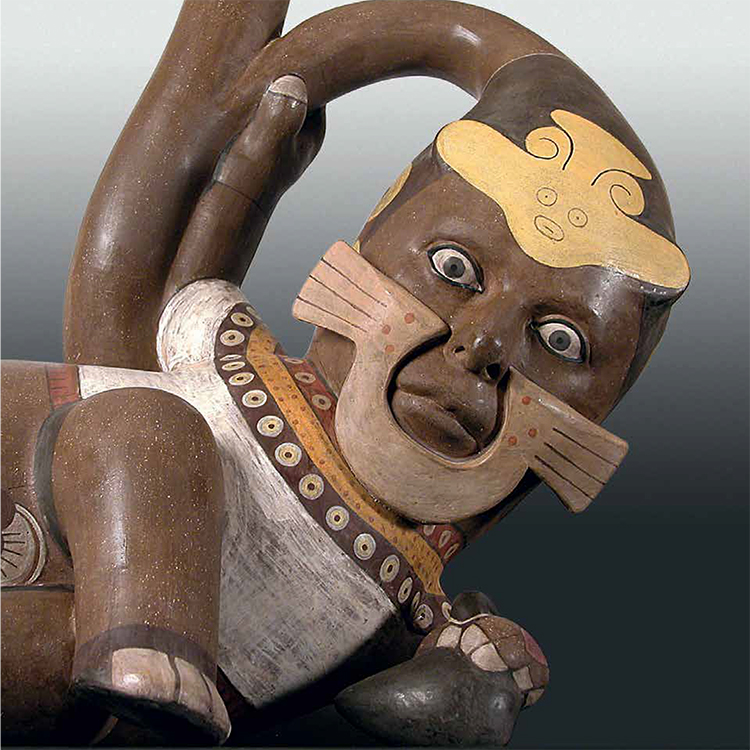Here is a book unlike anything else in cfile.library. It is a comprehensive dip into some of Kukuli Velarde’s biggest exhibitions between 2004-2012. We are so grateful to Velarde and Instituto Cultural Peruano Norteamericano in Lima for allowing us to make Patrimonio available in cfile.library. If you are a member, view the book in cfile.library, or begin your 14-day free trial!
Click Here to Download the Intro to Kukuli’s Exhibition Catalog
Patrimoino: Kukuli Velarde
Clark, Garth; Tanaka, Carlos Runcie; Koplos, Janet; Copeland, Collette
Lima: Instituto Cultural Peruano Norteamericano, 2013
Spanish, English Translation
142 Pages
Painter and ceramic sculptor Kukuli Velarde uses her art practice to continue exploring her heritage and sexuality. She compromises aspects of famous European and Peruvian paintings into her own work. Her art is full of conflict that reflects her own inner conflict as a descendant of both native Peruvians and Spanish colonists. This crossover between her European and South American heritage is most present in her painting, when she emulates famed compositions, such as in her painting La Pieta: she replaces the Jesus figure with herself topless, wearing tighty whities and a heart and arrow tattoo on her thigh. Gold paneling borders the scene. Her sarcasm is dark humor, but also pointed and deservedly bitter.
In another painting, Santa Chingada: The Perfect Little Woman, a figure in green dress and halo with the artist’s visage is surrounded by small white angels with giant penises. The figure wears a horse bridle in her mouth, a chastity belt around her pelvis, and barbwire surrounds her. In Spanish, Chingada means the offspring of the male Spanish and the Native women. The painting elicits the feeling of at once being lauded and admired, but scorned, dominated, and possessed.
Having grown up in Peru, where the bloody, flashy and ornate iconography of Catholicism remained after colonialism had fled, Velarde admits, “my identity as a person and as an artist is marked by this aesthetic.” In the book, Velarde explains that during Peru’s period of colonization, all art produced by native Peruvians was a forced imitation of European (Spanish) art. She states, “It intrigues me how the artists knowingly or unknowingly preserved characteristics of their own aesthetics in design and in composition, and how Pre-Columbian entities managed to survive through an unsuspected format.” Velarde’s work recreates this mystery, drawing from European and Peruvian aesthetics, and with her own visage as the main character of the painting.

Kukuli Velarde, Najallota Insolente. Playfully disobedient. Does not believe in hierarchies, la hija de la gran, Maya, Mexico 750 B.C, 2006
Velarde’s figurative ceramic sculptures appear separate from her paintings in the book, but are contextually similar. Here, the artist sympathizes with all the Pre-Columbian art objects collecting dust on shelves in the back of museums. Her sculptures give them a voice and a personality, which is a lot of the time vulgar and other times hysterical and violent. She states, “[My sculptures] are awakened and they are aware of being watched. The may be well cared for, as exotic animals in a zoological entertainment center, but they are trapped, estranged from context and stripped of all meaning.” They wear traditional Peruvian hats, color, face paint and jewelry, often with the body of an animal. This, paired with an attitude and body language that Velarde defined pejoratively when she titled these pieces. Each piece represents another period in Pre-Columbian art history. Speaking of the titles Velarde states, “the same [names] you, and many like you and I have endured because of our indigenous ancestry.” Check out the captions under the ceramic sculptures for a better idea.
For her show at Garth Clark Gallery in 2007, Plunder Me, Baby, the gallery and the artist replicated basement storage of a European anthropology museum, which meant Velarde’s ceramic sculptures were shown on metal warehouse shelving with aged labels that told the title of the works, “museum style.” Her ceramic sculptures play the part of stolen Pre-Columbian art collections that no one can see to study anymore, and Europeans are not sure what to make of them.

Kukuli Velarde, Méndiga Perra Autoctuóna, Bites. Will not trust. Likes tough love, Colima, Mexico, around 1500 BC, 2007

Kukuli Velarde, India Cojuda, She does as if she doesn’t like it, but she does…. Nazca phase 1, Péru, AD 100, 2007
If you are a member, view the book in cfile.library, or begin your 14-day free trial!
Click Here to Download the Intro to Kukuli’s Exhibition Catalog



I see these on Facebook. I wish the one posting would clarify that these are not original objects from their indigenous roots but the work of a contemporary artist. Jenny Mendez Ceramics is the poster.